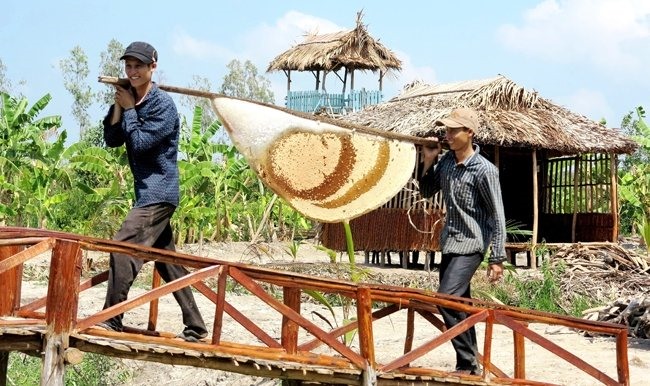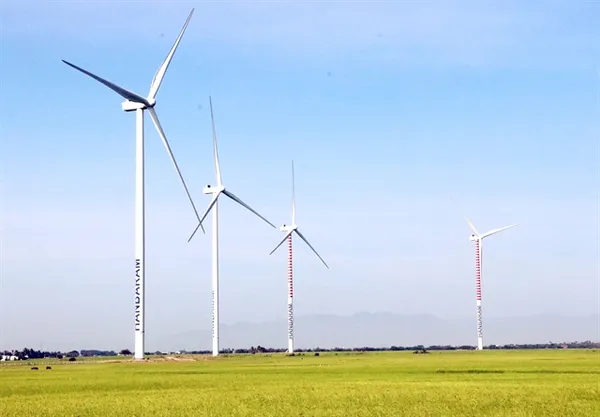 Society
Society

In U Minh District in the southernmost province of Cà Mau, there is a popular job called “gác kèo ong” which literally means 'the guard of honey bees hives'.
 |
| Swiping left: Trần Văn Nhì from Nguyễn Phích Commune, U Minh District has worked as “gác kèo ong” for over 40 years.In this photo, he is using tinder, producing smoke to make bees get out of their hives. — Photo nhandan.com.vn |
CÀ MAU — In U Minh District in the southernmost province of Cà Mau, there is a popular job called “gác kèo ong” which literally means ’the guard of honey bees hives’.
The guards make “kèo ong” to lure bees to come and build their hives; they will then wait to harvest the honey.
The “kèo” is usually made of a dry cajuput branch which is as wide as an adult’s calf, and is about two or three metres long.
Before being taken into the forest, the “kèo ong” is covered with beeswax to lure bees. Two holes are made at the ends of the branch so that it can easily be held up in the trees.
The honey guards consider factors including wind direction, sunlight, and honey bees’ flight paths to select the best place to put the kèo ong. On top of this, the branch should hang at an incline of 60 degrees to ensure sunlight can reach it.
Experienced guards can predict exactly when the bees will arrive at the kèo ong to build hives; they also know how long it will take for the bees to produce enough honey to be harvested.
Trần Văn Nhì from Nguyễn Phích Commune, U Minh District told Nhân dân (People) newspaper that he worked as “gác kèo ong” for more than 40 years.
Before collecting honey, the honey guards burn tinder wood next to the hives, which causes the bees to flee, he said. When collecting the honey, it is important to leave some honey cones, so that bees can return to the hive to produce more.
Nhì said that honey which is collected in cajuput forest in Nguyễn Phích Commune is a reddish colour because bees collect nectar from cajuput blossom, while honey collected in U Minh Hạ National Park is usually golden because bees collect nectar from various different blossoms.
“Domestically-raised bees drink sugar water, forest honey bees don’t, even if people put sugar water near their hives for months,” Nhì said.
“We grow cajuput trees and protect the cajuput forest so that when they blossom they give us more honey,” Nhì said, adding that by making the kèo ong they are also making homes for the honey bees.
 |
| Sweet dreams: Men carry a kèo ong after harvesting bee honey from cajuput forest in southernmost province of Cà Mau. — Photo nhandan.com.vn |
Thanks to some 260 kèo ong, Nhì’s family collects 400-500 liters of honey every year.
Cajuput blossoms bloom during the dry season from September to March in the lunar calendar. It’s the time when bees make the most honey, so it’s also the time for guards to collect honey. The volume of honey collected during the dry season is double that which is collected during the rainy season.
In1984 local bee hive guards established a group to share information and experience on their work. The group is now a cooperative with many members, monitoring more than 7,200 kèo ong in a cajuput forest area of 520 ha.
As the cajuput forest is part of Cà Mau Cape Reserve Area, members of the cooperative are offered technical training and protective equipment to collect honey and avoid causing forest fires.
Director of the cooperative Nguyễn Văn Vững said that once joining the group, members are required to strictly follow its rules, which include the protection of the forest, a ban on fire, not adding sugar to honey, and not stealing the kèo ong of other guards.
During the rainy season, honey collectors can apply traditional methods to collect honey, but during the dry season they have to wear protective clothes, and use special equipment to avoid causing fires when smoking out the hives.
“If anyone violates these rules, they will have to leave the cooperative,” said Vững.
Chairman of U Minh District People’s Committee Dư Bé Ba said that the U Minh Hạ cajuput forest covers an area of over 43,000 ha, and thousands of local families earn their living by working as gác kèo ong.
“When they work together in cooperatives, they are better at protecting forest,” Ba said.
On the forest area that the honey guard cooperative was allocated and has managed for more than 20 years, no forest fire has ever been reported, Ba said.
“To local residents, the forest and the honey are a key source of income, so if the forest is lost, so is their livelihood,” Ba said.
Recently, the local authorities in Cà Mau Province have joined forces with local residents to offer tours for people to experience honey collecting, in an effort to help local people to earn more. — VNS









